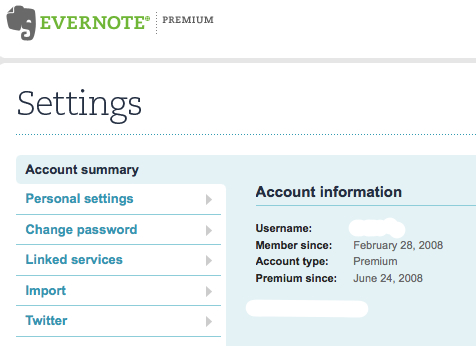Call me an Evernote evangelist if you like. It’s actually rather accurate. Evernote is probably the single most important productivity tool that I use. Looking back over my “relationship” with the service I realized that I’ve been involved with Evernote from early on. I joined the beta program within days of that initially rolling out. And I became one of their premium users every day it became available. There isn’t a single day that goes by that I don’t actually use Evernote numerous times and I never miss an opportunity to tell others about service and to encourage them to give it a try.
That’s why it was such a pleasure for me to spend an hour meeting with Evernote CEO Phil Libin during CES last week. The conversation gave me some insight into where the company was, where it’s going and why, under his leadership, it has been so successful so quickly.
It was only a few short weeks ago that I reported that Evernote had reached its 2 millionth user. That’s a huge number considering the fact that the service has only been out of beta for less than two years. Perhaps even more impressive is the fact that the iPhone application is, by far, the most important way that people are accessing their Evernote accounts.
Libin came on during the summer of 2007. It wasn’t a good time for the company. They were effectively operating hand to mouth and the future was not at all clear. Libin saw the vision and embraced the concept behind Evernote but discovered a company whose survival was far from assured. Fast forward to today and the finances of Evernote look entirely difference. Revenue is growing quickly. Premium Users are now growing faster than free users and the conversion rate from free to premium users (key to the company’s business model), while still growing slowly, has increased in speed. Now, instead of worrying about whether or not they will have money for next month’s payroll, they are able to talk in terms of five year plans. In fact, they expect full cash profitability in a bit over a year. That is quite a turnaround!
The Evernote Business Model
I found Evernote’s business model to be rather interesting. The goal the company is to get people to begin using the service right away and then to have it become increasingly indispensible over time. Libin explained that this can occur because while there is a cap on how much new data a user can put into an account each month once the data is in an account it is in permanently and without any additional fees. As a result over time the amount of data in an account continues to grow as more and more memories are added.
My perspective on the whole approach changed when Libin explained it to me in this way…
I think about how much is my Evernote account worth to me. At first it was of minimal value. I had a few pictures in a few documents it. If my account was taken away from me the next day it wouldn’t be a big deal. After few months, however, it was worth far more. Now it was a collection of pictures, notes and a variety of thoughts that I had for months on end. The value of the account — more accurately the value of the data in the account — have increased exponentially.
Fast forward over a year and my account has so much information that now that it is one of my most valuable possessions. It has a record of my life and it continues to grow with each passing day.
In other words, once somebody begins using Evernote in a serious way they will be more likely to use it, and rely upon it, for life. Key to this happening is the company’s commitment to having a free version that is truly a useful version rather than merely being a loss-leader. They have, to use his words, “a full commitment that there will always be a full version of Evernote and that it will always be great. The free version of Evernote is meant to be the main version.”
What kind of business model is it that allows them to simply give away service for free? That’s where the brilliance comes in. The company’s goal is to get people to use the free version and become so embracing of it that, at some point, they opt to become premium members and, as Libin said, “Give me $5 whether for one month or each and every month as a Premium user.” Perhaps, he explained, someone is taking a trip and needs the opportunity, during a short period, to upload far more information than the free account allows. For that month they can convert their account to premium, give Evernote five dollars, and upload a great deal more data. At the end of the month they can then downgrade to the free version without any kind of penalty. Or they might find it so useful to have the extra uploads and services that they stick with it. Best of all, because uploads are limited per month but stays in Evernote without any additional charge after that, the service becomes more and more central for capturing every aspect of life.
“But can you really build a successful company on some users paying $5 a month?” I asked? “Wildly successful” he answered with a smile.
(Personally I find the $45 a year I pay to be a Premium member one of the best tech bargains going and I’m glad that that rate the company is able to continue to build its services and ensure its future.)
Security and Redundancy
One of the things I focused on during our conversation was the question of data security. A number of us who use a web-based service to manage our tasks discovered that, due to a failure on the company’s servers data was exposed to loss. I asked if Evernote might fall victim to something similar. Libin explained that there are a number of important points to be made in this area. First, the company has built a tremendous amount of redundancy into their servers. That redundancy, in and of itself, means that data is well protected and in a variety of locations. More than that, however, he pointed out, the nature of the service brings its own form of security as well. Because Evernote it is, what I refer to as the hybrid-Web, the data is put into an account is found on multiple devices. Yes, it sits on the company’s servers but the same data is available, in my case for example, on my MacBook, my iMac, and, thanks to a recent update to the iPhone application that allows entire accounts to be stored as resident data on the iPhone, on my iPhone. That means that my data is stored on the company’s servers and on three different personal devices. The odds of all of them failing at the same time is as close to zero as possible.
In addition, the company is committed to allowing people to leave the service any time they like. Libin explained that one of the keys to making sure people want to stay with them is making sure that people know that they’re free to leave anytime they want. As he put it, “any country you’re free to leave this country are free to live in. And any service you are free to drop at any time is a service you more likely to remain with for a long time.”
As a result, “You own the data you put into Evernote”, he said. Locally notes are stored in two different formats. One of them stores all of the metadata and the other is more universal. Both of them are completely open and anyone is free to write code that will allow data to be exported to any other service. That kind of freedom means that people are more likely to feel safe putting valuable memories in the company’s hands.
The Coming Months
So what’s the goal for the coming year? “Polish, polish, polish” Libin said. After all, the company has updated its Mac, Windows and iPhone applications numerous times. As noted previously they recently enabled iPhone users to store their data locally. It was a huge technological challenge but one that they finally achieved and achieved in a matter that is fast and safe enough to roll out. That one change, which happened to be the most requested feature for iPhone users, led to a huge bomb in the number of free account holders converting to premium users. In addition the company recently rolled out its Android client and it has been well received.
Finally, Evernote is excited about the partnerships that they have created with other developers who use of the open API. That allows Evernote to “not be the best at anything went to the underlying foundation upon which our partners will build.” There are already 16 applications that have integration with Evernote and there are already 600 third-party developers working with them. High on the priority list — better handling of business cards and native voice transcription. Judging from what the company has done with their clients thus far only surprised if it’s very long before we see both.
There’s one last thing I’ll note before ending this post. At one point I asked, “I assume it, especially since I’m a stranger, that everything you’re sharing with me is open and postable?” To this Libin responded that that was indeed the case. he went on, however, to note that from the moment he took over the reins of the company he has been committed to being far more open with any and all information about the company than most CEOs are. His feeling is that by being open about numbers, coding etc. they simply enhance the value of Evernote and make it more likely that others will want to partner with them in advancing the service.
As I stated at the beginning — I am an Evernote evangelist. I rely upon the service in my daily life. I use it professionally, personally, and for much of what I do here on the website. I do most of my writing in Evernote since that way I know that it’s always accessible no matter where I go. I have most of my professional documents saved in my Evernote account so that they are always accessible to me. Now, having spent time with Libin, I understand even more fully why the company has been as successful as it has been… and why I will continue to tell everyone I can about it.



Nice article.
I like and use Evernote a lot too, but I would love it if they would do some major updates on their WM client too, not just iPhone.
Having all my data available on my device (offline) is one such thing and the other major thing that would make this service trully great would be ability to edit existing notes on mobile device, not just plain text, but any note – that would really be awesome.